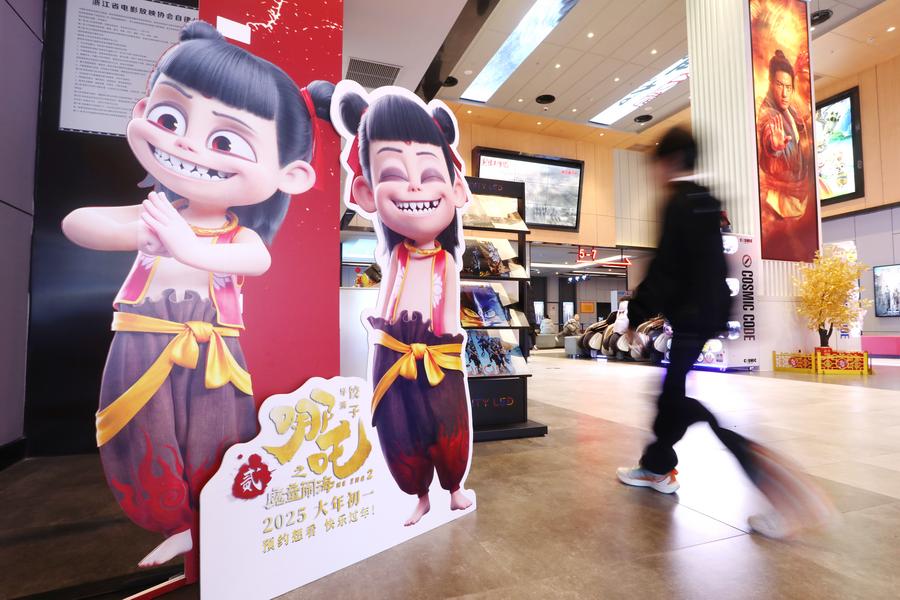
This year's Spring Festival film season has set several records. For one, the Chinese film industry shattered the revenue record with a staggering box office of about 9.51 billion yuan ($1.33 billion) and 187 million pairs of footfalls in the cinema.
In particular, Ne Zha: Demon Child Conquers the Sea, or Ne Zha 2, has shattered multiple box office records, becoming the first film to earn $1 billion in a single market and the first non-Hollywood production to join the coveted billion-dollar club. The movie also debuted in the US over the weekend.
The film's market performance not only confirms the commercial potential of Chinese animation films but also marks a historic breakthrough for the country's movie industry. In fact, Ne Zha 2's success reminds us of the glorious beginnings of Chinese animation films. As early as the 1960s, the Shanghai Animation Film Studio made Havoc in Heaven, a landmark animation film that took the world by surprise with its unique oriental aesthetics, and won global acclaim.
READ MORE: Ne Zha collectibles catch blockbuster movie's coattails
Incidentally, Ne Zha 2 has once again showed the world the potential of Chinese animation by adopting a mythological story for a modern production, creatively combining traditional values with modern spirit through the narrative. Its special effects are comparable to those of Hollywood blockbusters. The film revives the creative spirit of the Chinese film industry.
The revival of Chinese animation is essentially a breakthrough both in the industrialization process and artistic exploration. Chinese animation films have a glorious history, but after hitting rock bottom, they had been passing through a period of confusion. For years, Chinese animation films, made only for children, were looked down upon.
It was not until Monkey King: Hero Is Back was released in 2015 that the animation genre got a shot in the arm. That Monkey King's box office reached 956 million yuan is proof of the quality of the work. The film marked an inflection point in the industry, with film financiers and producers, as well as directors discovering the huge potential and artistic value of animation films.
Since then, China's animation industry has developed, both artistically and technologically, gifting a series of excellent works including the White Snake trilogy, Big Fish & Begonia and Jiang Ziya: Legend of Deification. These excellent productions reflect the uniqueness of Chinese animations and the artistic spirit of Chinese animators.
The success of Ne Zha 2 is not accidental. Compared with its prequel, the film has a more fleshed out narrative and refined theme. The movie continues from where the prequel left, but the theme changes with Ne Zha's decision on whether to be a fairy or a demon.
With the help of superb special effects, the film subverts the traditional story of Ne Zha. Dialogues such as "If there is no road ahead, I will carve one myself", resonate with the audience because they are a metaphor for the rebellious spirit and free will of today's youths who refuse to accept fate and work determinedly to reach their respective goals.
The theme of the film, which is good defeating evil to deliver justice, reflects Chinese philosophy — that the individual, the family and the state are all intimately linked, and the ultimate goal is to build a community with a shared future for mankind.
To be sure, the excellent animation films being made of late are the result of the upgrading of the Chinese animation industry. The participation of more than 130 companies in the production of Ne Zha 2 shows the industrial cluster effect and pragmatic division of labor.
It's the support of the entire Chinese animation industry that has made the movie so successful. The film is a product of collectivist values, and testifies to the role of the "technological community" in promoting the industrial upgrading of the animation industry.
ALSO READ: Cultural spillover effect bears rich dividends
But the modern animation industry in China is still in its early stage. Although Ne Zha 2, which took five years to make and involved massive amounts of money, has achieved unprecedented success, it is still an exception to the rule. Most animation films still face budget constraints and lack technical finesse.
There is a need therefore to standardize the production system and talent training mechanism. Ne Zha 2 has raised the audience's expectations. As a result, moviegoers will now demand good quality work, meaning animation films will now have little room for error, with quality and creativity being their core competitive advantage.
China's rich history and culture have been empowering Chinese animation artists for generations. Now they need to translate the abundant cultural resources into modern animation language. The animation industry is expected to make greater breakthroughs in projecting oriental aesthetics expression, creative storytelling and technological innovation now that Ne Zha 2 has set very high standards.
The author is a professor of School of Music and Film at Tianjin Normal University.
The views don't necessarily represent those of China Daily.


